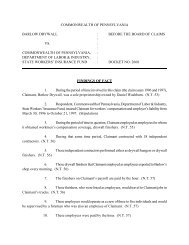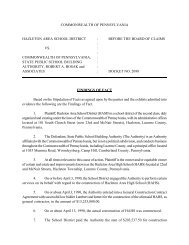3720 - Board of Claims
3720 - Board of Claims
3720 - Board of Claims
Create successful ePaper yourself
Turn your PDF publications into a flip-book with our unique Google optimized e-Paper software.
Super. 1963); Angelo Iafrate Const. Co. v. Pennsylvania Turnpike Commission, No. 3654, 2006<br />
WL 2585020 at *29-30, 41-42 (Pa. Bd. <strong>Claims</strong>, July 27, 2006); W.P. Dickerson & Son, 400 A.2d<br />
at 932; Allentown Supply Corp. v. Stryer, 195 A.2d at 279.<br />
To be specific, the guy wire problem emanated from the fact that these extra supports<br />
gave the poles a larger footprint, and PennDOT's design team had not provided sufficient space<br />
for relocation <strong>of</strong> the pole and guy wires within its right-<strong>of</strong>-way when it issued its relocation<br />
permits specifying the location <strong>of</strong> the new poles and its plans and drawings. When this guy wire<br />
problem was discovered in August 2001, at the beginning <strong>of</strong> work on the Project, the Utilities<br />
brought this problem to PennDOT’s attention even as they tried to resolve the problem by<br />
requesting permission from an adjacent property owner to place the guy wires on his land. When<br />
the owner(s) refused unless paid for the encroachment, PennDOT personnel, including<br />
Mr. Pilosi, were consulted, and PennDOT decided it could not or would not pay the property<br />
owner(s) to place the guy wires on their property.<br />
The Utilities could not move their poles<br />
because there was no room at the designated location for the supporting guy wires and were<br />
delayed while awaiting PennDOT’s solution. Ultimately, in March 2002, seven months after<br />
initial notice <strong>of</strong> this problem, PennDOT redesigned the affected areas <strong>of</strong> the roadway to make<br />
room for the guy wires within its right-<strong>of</strong>-way. This design mistake, and PennDOT’s slow<br />
resolution <strong>of</strong> the problem, allowed the obstructing poles to remain in place for over seven months<br />
from August 2001 until March 2002.<br />
Although not immediately apparent from initial review <strong>of</strong> this case, it is this design<br />
problem and the slow, drawn out resolution <strong>of</strong> same during construction which we find to be the<br />
most significant factor in delaying the pole relocation and disrupting the Project. That is to say,<br />
although the problem with guy wires may have affected and prevented placement <strong>of</strong> only four or<br />
85






